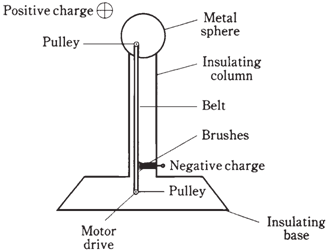Static electricity
Charge carriers, mainly electrons, can build up, or become deficient, on things without flowing anywhere. You have probably experienced this when walking on a carpeted floor in the winter, or in a place where the humidity was very low. An excess or shortage of the electrons is created on and in your body. You acquire a charge of static electricity. It's known as "static" as it doesn't go anywhere. You do not feel this until you touch some metallic object which is connected to earth ground or to some large fixture; but then there is discharge noticed, accompanied by a spark which might well startle you. It is the current, during this discharge which causes the sensation which might even make you jump.
If you were to become more charged, your hair would stand on end, as every hair would repel every other. Like charges are created either by an excess or a deficiency of electrons; they repel each other. The spark might jump an inch, 2 inches, or even 6 inches. Then it would startle you; you could get hurt. This does not happen with ordinary carpet and shoes, fortunately. But a device called as a Van de Graaff generator, which is found in some high school physics labs, can cause a spark this large. You have to be careful while using this device for the experiments of physics.

Figure-- Simple diagram of a Van de Graaff generator for creating large static charges.
In the extreme, lightning takes place between clouds, and between clouds and ground in the atmosphere of earth. This spark is a greatly magnified version of the little spark you get after shuffling around on the carpet. Until the spark occurs, there is a static charge present in clouds, between different clouds or parts of a cloud, and the ground. In the given Figure cloud-to-cloud (A) and cloud-to-ground (B) static buildups are shown. In the case at B, the positive charge in the earth follows along beneath the thunderstorm cloud like a shadow as the storm is blown along by prevailing winds.
The current in a lightning stroke is several tens of thousands, or hundreds of thousands, of amperes. But it takes place for a fraction of a second only. Still, many coulombs of charge are displaced in the single bolt of lightning.